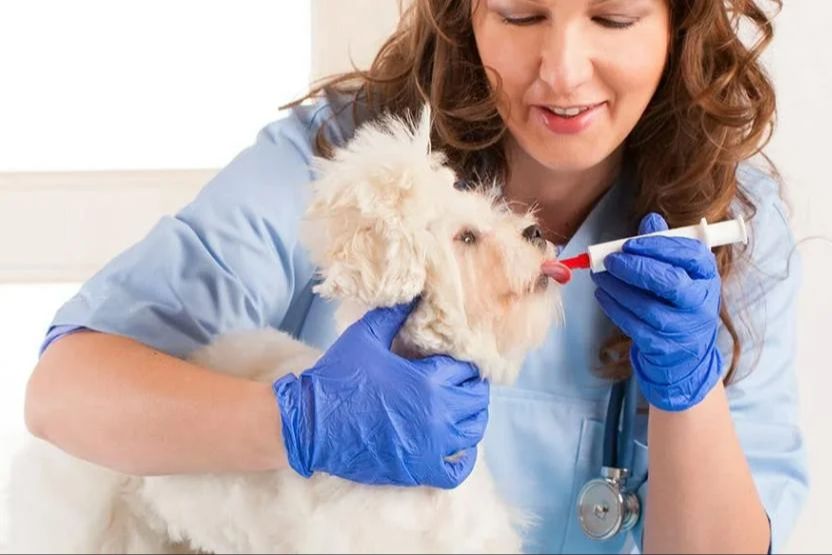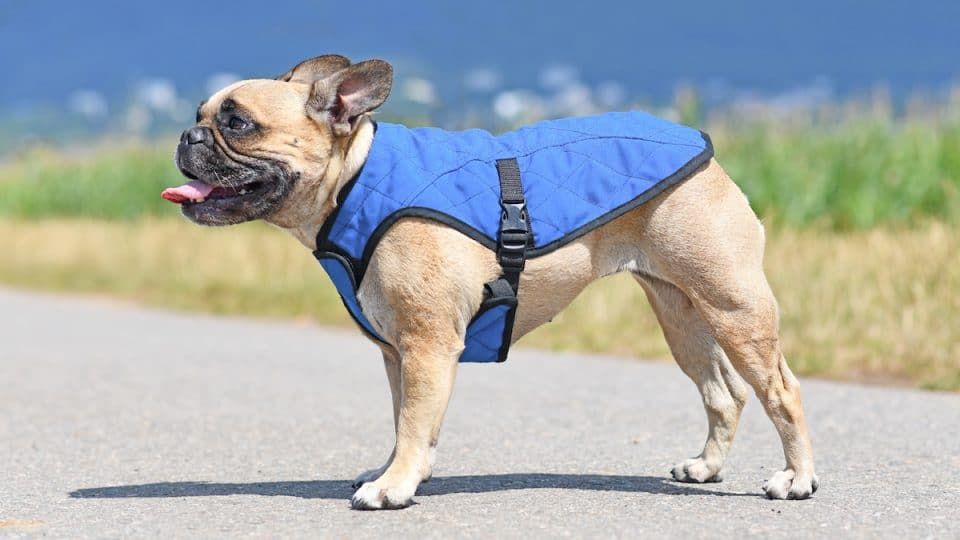Introduction
Dogs pant to help cool themselves down since they do not sweat like humans. Panting allows dogs to circulate air through their nasal passages, which helps lower their body temperature (source). While some panting is normal, excessive panting can be a sign that a dog is overheating or becoming dangerously hot.
When dogs get too hot, they are at risk for heat exhaustion or heat stroke. Heat exhaustion causes weakness, heavy panting, and vomiting, while heat stroke is a life-threatening medical emergency (source). Therefore, it is critical to recognize the signs of overheating in dogs and take action to safely cool them down.
The goal of cooling down an overheated panting dog is to bring their body temperature back to a normal range. This involves moving them to a cooler area, providing water, applying cool water or ice packs, and allowing rest. Taking quick action can prevent more serious medical issues from developing.
Recognize the Signs of Overheating
Dogs are unable to regulate their body temperature as efficiently as humans. As a result, they are at risk for overheating on hot days. According to the AKC, signs that a dog may be overheating include:
- Heavy panting – Dogs pant to cool down. Excessive panting is a warning sign a dog is too hot.
- Excessive drooling – Heavy drooling is the body’s way of releasing heat.
- Bright red gums – Red gums indicate increased blood flow to dissipate heat.
- Lethargy/weakness – An overheated dog may begin to lag behind on walks or become reluctant to move (AKC).
- Collapsing – In extreme cases, heat stroke can cause a dog to collapse (Vergi247).

Pay close attention on hot days for these signs of heat stress. If you notice any of these symptoms, take steps right away to cool your dog down.
Move the Dog to a Cool Area
If your dog is showing signs of overheating, it’s important to move them to a cooler area as soon as possible. This could mean bringing them indoors or at least into the shade outdoors (source). Getting them out of direct sunlight is crucial to start lowering their body temperature.
If you have air conditioning in your home, bring your overheated dog inside and crate them or keep them restricted to one cool room. Make sure the room is a comfortable temperature between 68-78°F (source). Position fans to blow air over your dog’s body to promote evaporation and cooling.
If you don’t have AC, look for rooms with tile or wood floors, which will feel cool against your dog’s belly and paws. You can also wet a few towels with cool water and lay them on the floor for your dog to lay on (source). This mimics the cooling sensation of grass.
When outside, move your dog into the shade of trees or a covered patio or bring them indoors. Grass or dirt is cooler than asphalt, so have them lay down in those areas if shade isn’t available.
Offer Cool Water
One of the most important things you can do for an overheated dog is to provide fresh, cool water. Allow the dog to drink slowly and take frequent breaks. Do not allow the dog to gulp a large amount of water quickly, as this can cause vomiting or bloating.
Offer water in a bowl, bottle, or with your hands. You can also offer ice cubes for the dog to lick, which will help lower their body temperature. Give them a few cubes at a time and monitor to make sure they do not choke. Avoid giving extremely cold water from the tap or hose, as the temperature change could cause vomiting.
If the dog seems unwilling or unable to drink on their own, use a needle-less syringe to slowly squirt water into their mouth. Go slowly and give small amounts at a time. The goal is to rehydrate the dog and bring their temperature down gradually.

Be patient and keep offering cool, fresh water until the dog’s signs of overheating start to improve. Providing water is one of the most crucial steps in cooling and recovering an overheated dog.
Apply Cool Water
One of the quickest ways to cool down an overheated dog is by applying cool water to their body. Focus on areas where there are a lot of blood vessels near the surface of the skin, like the paws, belly, armpits, and neck. The cool water will help constrict blood vessels, slowing blood flow to the skin and cooling the blood before it circulates back to the body’s core.
Start by wetting your dog’s paws and belly with cool, fresh water. You can use a spray bottle, hose, or bucket. Make sure the water is cool but not icy cold – extreme temperature changes can cause shock. According to The Canine Training Center, you should use “luke warm, not hot or ice cold” water when dousing an overheated dog.
Also soak some towels or rags in cool water and drape them over your dog’s back, sides, and neck. The wet fabric will help transfer heat away from their body. Replace the towels frequently to keep them cool. Just make sure to avoid over-wetting your dog’s coat as sopping wet fur can actually insulate heat.
Never use cold or icy water, as rapid cooling is dangerous and can cause shock. Lower your dog’s body temperature gradually with cool, fresh water. And be sure to monitor them closely during the cooling process.
Consider a Cooling Vest or Mat
One way to help cool down an overheated dog is to use a specialized cooling vest or cooling mat. These products are designed to remove excess body heat and help maintain a normal body temperature. Cooling vests for dogs can be worn when taking them outside on hot days, and cooling mats can provide a cool place for them to lay down indoors.

Cooling vests and mats contain materials that can be frozen or cooled and then activated to provide cooling through evaporation or direct contact. Many feature gel packs or phase change material that can be chilled in the refrigerator or freezer. As the material warms against the dog’s body, it absorbs excess heat. This provides a cooling effect for 30 minutes to several hours depending on the product. The packs can be re-chilled and reused repeatedly.
According to sources, some of the top-rated dog cooling vests provide 2-3 hours of cooling relief when frozen. They are constructed with breathable, lightweight materials that allow air flow. Cooling mats and beds also utilize gel or water cores to absorb and dissipate heat without getting your floors wet. They provide dogs a cool spot to rest when indoor temperatures climb.
Using a cooling vest or mat can help regulate your dog’s temperature and prevent overheating. Just make sure to follow product instructions carefully and monitor your dog’s comfort level while using one.
Allow Rest
Once you have moved the overheated dog to a cool area and provided water, it is crucial to allow the dog adequate rest time for its body temperature to return to normal. Do not force the dog to engage in any activity or exercise during this recovery period, as physical exertion will raise the body temperature again. Simply allow the dog to rest in a cool, shaded area with access to fresh water.
While the dog is resting, carefully monitor its breathing and panting. As its body cools down, the heavy panting should gradually subside. However, if the breathing seems excessively labored or the dog has trouble standing up, immediately contact a veterinarian, as these can be signs of heat stroke requiring emergency care (https://emergency-vets.com/species/dogs/dogs-heat-stroke-stress-summer/). Otherwise, allow the dog to fully recover before engaging in any activity again.
Once panting has stopped and the dog seems comfortable again, it should be safe for mild activity. But continue monitoring body temperature and panting carefully over the next 12-24 hours, as dogs recovering from overheating are still prone to recurrence.
Consult a Vet If Needed
If your dog’s panting and signs of overheating do not improve after you have moved them to a cool area and applied cooling techniques, it is important to contact your veterinarian. Prolonged heavy panting, excessive drooling, weakness, vomiting, diarrhea or collapse are signs that something more serious could be going on and require immediate veterinary attention.
Underlying health conditions like heart disease, laryngeal paralysis, or other respiratory issues can make dogs prone to overheating more easily. If your dog frequently struggles with getting overheated, have your veterinarian evaluate them for any underlying problems that may be contributing.
In severe cases of overheating, heat stroke can occur which is a life-threatening emergency. If your dog’s gums turn bright red or purple, they collapse, have seizures, or become unresponsive, bring them to an emergency vet clinic right away as this indicates heat stroke. Immediate veterinary treatment with aggressive cooling and supportive care can help prevent lasting organ damage or death from heat stroke.
While cooling your overheated dog at home is important, if their signs do not improve or worsen, always consult your veterinarian for an examination and guidance, especially if heat stroke is suspected. Proper treatment for heat stroke can help prevent devastating outcomes.
Preventative Measures
There are several things you can do to help prevent your dog from overheating in the first place:
- Provide access to shaded areas and plenty of fresh, cool water. Dogs should always have water available, but be especially diligent on hot days (according to https://www.akc.org/expert-advice/health/dogs-overheating-signs-symptoms-prevention/).
- Limit exercise and outdoor time during peak heat hours. Take walks in the early morning or evening when it’s cooler (according to https://be.chewy.com/how-to-cool-down-a-dog-overheating/).
- Keep coats well-groomed. Matted, long fur can trap heat. Schedule regular brushing and grooming (according to https://www.aarp.org/home-family/friends-family/info-2020/protect-dog-from-overheating.html).
- Apply dog-safe sunscreen to vulnerable areas like the tips of ears and nose 30 minutes before going outside.

Taking preventative steps can help keep your dog cool and comfortable even on hot days.
Conclusion
If your dog is panting heavily and showing signs of overheating, it’s important to take action right away to cool them down. Start by moving them into a shaded, well-ventilated area and providing cool drinking water. You can apply cool water to their paws, belly, and ears and consider using a cooling vest or mat if the situation is severe. Allow your dog ample time to rest and recover, keeping a close eye on them in case a vet visit becomes necessary.
It’s crucial that dog owners are aware of the dangers of overheating and know how to respond quickly. Heat stroke can become fatal fast if left untreated. By following the steps outlined in this article to lower your dog’s body temperature, you can help them comfortably cool down and avoid any lasting health issues.
Going forward, take preventative measures on hot days like limiting exercise during peak heat hours, ensuring access to shade, and providing ample cool drinking water. Monitor your dog closely for early signs of overheating like heavy panting. When in doubt, call your veterinarian for guidance. With proper vigilance and care, you can keep your dog safe and healthy all summer long.
